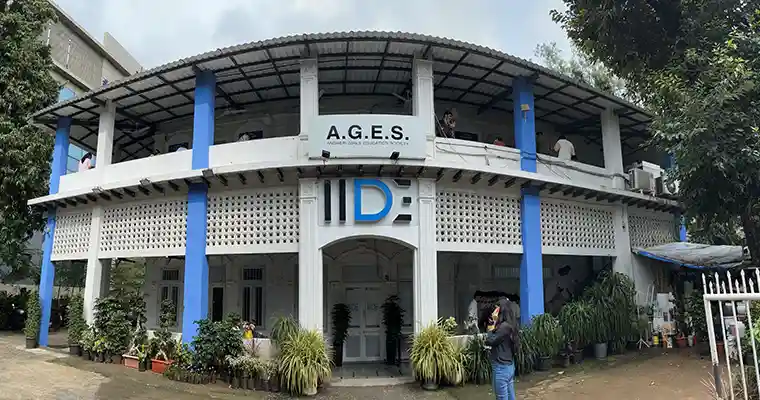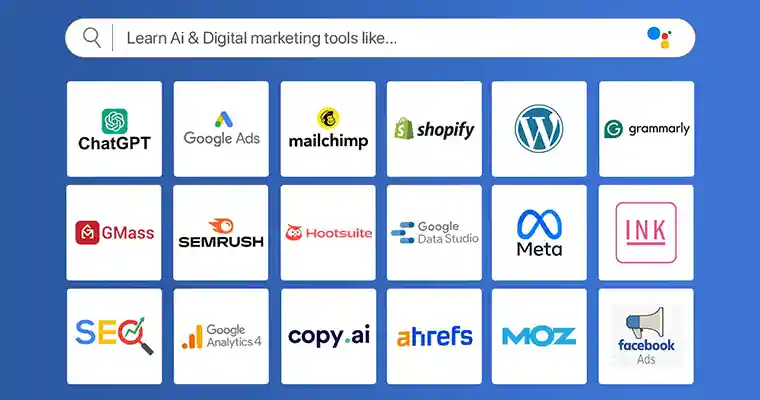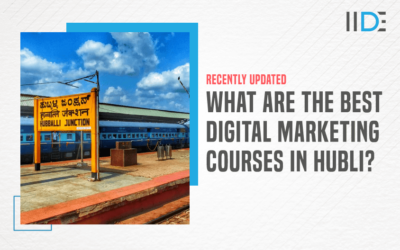Quick Read
Backlinks are crucial for SEO, acting as votes of confidence that boost a website’s authority and ranking. Quality backlinks improve visibility, referral traffic, and overall site credibility. The article explores types of backlinks, link-building strategies, and Google’s evolving algorithms, emphasizing best practices for effective backlink management.
Learn From Asia’s #1
Digital Marketing Institute
AI-Based Curriculum
Dive in to the future with the latest AI tools
Placement at top brands and agencies


 & more...
& more...

Ever stumbled upon a blog post with certain words or phrases highlighted in blue? Those links, known as backlinks, are like word-of-mouth recommendations for your website, boosting the credibility of quality backlinks and search engine rankings.
Imagine backlinks as votes of confidence. The more reputable websites link to yours, the more Google sees you as a valuable resource. This can significantly improve your website’s visibility and attract more organic traffic.
In this post, we’ll dive deep into the world of backlinks, exploring:
- What do backlinks matter? Understand their role in SEO and how they can benefit your website.
- Different types of backlinks: Learn about the various backlinks and their impact.
- How to build quality backlinks: Discover effective backlink-building techniques to acquire high-quality backlinks.
- Backlink best practices: Avoid common pitfalls and optimise your backlink strategy.
Ready to unlock the power of backlinks and skyrocket your website’s rankings? Let’s get started!
PS: If you too want to earn a little extra on the side and build a side hustle in a field of your choice, then don’t forget to check out this make-money-from-home free masterclass now.
What are Backlinks?
Backlinks are links from one website to yours (a link that one website provides to your website). For example, site A provides a link that leads the readers to site B. Backlinks and SEO are one of the most important metrics that help determine your website’s ranking or the quality of backlinks that your site receives, which have grown significantly over time.
Let’s understand it better with the help of an example. For instance, in the past, Google would consider a link from one site to another as a ‘vote’, as in a recommendation for your page from another site. The more you receive, the more Google C trusts your page to get authority. So, the pages with the most links rank highest on the results page.
However, today, your backlinks will require you to meet many criteria for high quality. With higher authority, expertise, age, and relevance of your site’s link, each quality backlink or vote your site receives will be more decisive.
Understanding backlink strategies and backlinking for beginners can help you build a robust backlink profile and improve your site’s SEO performance.
Inbound vs. Outbound Links: How Do They Affect SEO?
As you are now aware of the concept of backlinks, let’s understand the concept of Inbound and Outbound backlinks.
External Links
Outbound links are the links you insert on your blog page or website that will take your audience out of your website to other websites. These links share their authority with other sites and play a significant role in backlinking for beginners.
Understanding how backlinks work and their importance can greatly enhance your SEO efforts. Backlink-building techniques help in creating quality backlinks, which improve your site’s authority and search engine ranking.
Inbound External Links
Inbound external links (backlinks) direct links from an external website to the website. For instance, if Wikipedia mentions your website on its page and includes a link that leads to your website, it is called inbound external backlinks or backlinks. This means that your website will receive traffic from the audience of Wikipedia to reach your website.
Outbound External Links
Outbound external links will take your audience out of our website and bring them to other websites. Frequently, they are employed within the content to provide additional context and connect readers to other sources that offer crucial information related to the current topic. For instance, when Wikipedia includes a link to your website, it takes the reader out of Wikipedia’s page.
This is an outbound link for Wikipedia. Understanding backlinks and SEO is crucial, as they help build backlink profiles and improve site authority. Backlink analysis, therefore, is vital for evaluating the effectiveness of these links and ensuring they align with backlink best practices.
Understanding backlinks is crucial for SEO, as they significantly determine your site’s authority and ranking. The difference between inbound and outbound interlinks entirely depends on one factor, which is the blog that receives and sends links to different blogs on the same website.
Inbound Internal Links
Backlinks are also referred to as inbound links, which occur when other websites link to your site (this means that another website’s audience will now be transported to your website when they click the link), and these links give you more authority.
The difference between inbound and outbound interlinks entirely depends on one factor which is the blog that receives and sends links to different blogs on the same website.
Outbound Internal Links
This is a scenario where your blog links to another blog on the same website. Continuing with the example above, when Bthe Blunt hair colour blog provides a link to another blog, it is considered an outbound Internal Link because it takes the user out of your blog but keeps them on the same website.
How do they affect SEO?
Inbound links transfer authority from the senders website to the receivers website and whereas outbound links transfers to authority in the oppsite direction. In simpler terms Inbound links increases SEO juice and vice-versa.
What is the significance of Backlinks?
I am sure you have now understood the basic concepts related to Backlinks. Now, let’s delve into the importance of Backlinks and how they can affect your website.
1. Improves Rankings
Google considers backlinks an essential indicator determining the rank of web pages on the SERP. There is a clear correlation between websites with many high-quality backlinks and improved ranking on SERP since Google considers external links to be votes of popularity for a website or webpage.
Understanding how backlinks work and implementing effective backlink strategies can significantly enhance your site’s visibility.
Interested in learning the tips and tricks to improve your blogs? Check out our blog, where we will share 18 Tips to help you create successful blogs. A few backlinks from websites with higher authority will have a more significant impact than many backlinks received from spammy, low-quality websites.
2. Google Finds New Pages Through Links
Have you ever wondered how search engines explore and navigate the vast web to discover all that hidden information? Welcome to the fascinating world of the ‘Crawling Process.’
Crawling is a process in which Google uses spiders, also called bots, to thoroughly search your website, which helps to determine the page’s relevance and, as a result, the ranking of your website.
Adding backlinks to this process makes it easier for Google to discover your content. As Google visits the page through a backlink, it crawls through the page and explores all the links it contains.
As a result, internal linking is a backlink strategy. This means that pages on your website provide links to other pages. This implies that once Google is on your site, it can track internal links to new pages and backlinks to your site.
This assists Google in understanding the structure of your site. Google will then crawl through your website and index its pages, increasing the probability of your page appearing in the search results.
3. Receive referral traffic to your page
When people visit your website through another site without searching for your website on Google it is called Referral Traffic.
The benefits of getting referral traffic include the following:
- Increased brand recognition
- Introduction to new audiences
- Opportunities for new qualified leads
- Improved authority from backlinks
- Get the opportunity to discover a new and diverse audience
- Better SEO through regular backlinks
Referral traffic can help people interested in your content to visit your website who can eventually even become your customers.
For those looking to specialise further, consider pursuing a post-graduation in digital marketing to deepen your expertise. This advanced qualification can open doors to senior roles and higher salary brackets. You’ll stay ahead in this competitive market with continuous learning and adaptation.
Or, By enrolling in an online digital marketing course, you’ll gain the flexibility to learn at your own pace while mastering essential skills. This approach allows you to balance your professional and personal commitments seamlessly. Moreover, the comprehensive curriculum ensures you stay ahead in the ever-evolving digital world.
Google’s PageRank Algorithm – an SEO Beginner Must Know
PageRank is the first algorithm that used Google to rank web pages on the search engine results page. It is named after the term “web page” and co-founder Larry Page. It helps to measure the importance of pages of a website.
Let’s assume that Bottle A has 900 ml of SEO Juice, and Bottle B has 500 ml of SEO Juice. When Bottle A links to Bottle B, a percentage of its SEO Juice is passed away. On the other hand, Bottle B will pass on a smaller percentage of SEO Juice because the DA of Bottle A has more authority than Bottle B.
Backlinks and SEO play a crucial role in improving a page’s ranking. The quality of backlinks can significantly impact the effectiveness of your backlink-building techniques.
Before moving on to the history of PageRank, I would like to inform you that the section “History of PageRank” is only for those readers who want to gain in-depth knowledge about PageRank. So, if you want to learn more about backlinks, you can skip this part.
History of PageRank
When Google was launched in 1998, it relied on the quality of content and metadata to determine the website’s ranking. This approach gave poor results when it was realised that the websites stuffed keywords to rank at the top of the SERP.
As a result, Google introduced PageRank to determine the website’s ranking. So, apart from looking at the frequency of keywords placed on a website, Google would focus on how backlinks work to determine the page’s ranking. According to Google’s philosophy, a link from one page to another counts as a “vote,” or a recommendation, for the page being linked to.
Additionally, Google felt more confident in the quality and authority of a page that received more votes. As a result, the pages with the most quality backlinks should appear first in Google’s rankings.
Previously, Google allowed us to see an estimation of a webpage’s PageRank through the browser toolbar, which represented the current web page PageRank between 0 and 10. Moving from TBRP 1 to TBRP 2 required a growth of a factor of 10, and moving to TBRP 3 required a growth of 100, making achieving every point of TBRP more challenging.
Google provided a rough estimation of a webpage’s PageRank through their browser toolbar for us to view. The challenge with Toolbar PageRank (TBPR) was that the SEO industry would use it to manipulate their content rather than focusing on the readability of the content.
So, in 2016, Google removed the Toolbar icon, though it never went away. Internally, Google changed the PageRank algorithm in 2006 with a new method of assessing links. Back to the present, PageRank estimates the significance of a website by counting the quantity and importance of backlinks pointing to a page.
The primary assumption is that a website can gain more authority when being linked by a site with a higher SEO PageRank score.
In simpler terms, PageRank (that is passed between websites in the form of links) will have a higher PageRank score. A page is seen as essential if other important pages connect to it, and the algorithm is built around this idea.
As mentioned, Google removed the toolbar so people could not view their web page rank estimate. Tools like Moz, Semrush, and Ahrefs saw this as an opportunity to make their version of PageRank, which gave birth to the concepts of DA (Domain Authority), DR (Domain Ranking), and AS (Authority Score).
Let’s dive deeper into the concept of Domain Authority.
Still a little confused? If you don’t want to waste so much time searching for the right course, then check out this digital marketing course to accelerate your career and stay ahead of the competition.
Or, to learn more about digital marketing, enrol now in this free digital marketing certification to kickstart your journey in the dynamic world and gain practical skills and industry knowledge.
What is Domain Authority?
Domain Authority (DA), an indicator created by Moz, determines how likely a website will appear in search engine result pages (SERPs). Scores for domain authority vary from 1 to 100, with higher scores indicating a higher possibility of ranking.
Additionally, you may quickly increase your DA score by altering your website. However, every time you achieve 1 point of DA score, acquiring another will become more challenging.
If your site is progressing, you will expect your DA to grow, but if your competitors’ sites are increasing at a more significant percentage than yours, then your DA score may remain constant or perhaps even decline. Backlink analysis can be useful in understanding these fluctuations.
For better accuracy, Moz is working on changing the way your DA scores. So, when you monitor your website’s DA, expect some changes. This score may be higher for some sites, but for others, it may be lower. Keep in mind the importance of backlinks in influencing your DA score.
Do’s and dont’s of Domain Authority
Here are some Do’s and dont’s that you should follow when using DA:
Do’s
- Use DA as a metric for making comparisons between sites that belong to similar caliber, category, or industry.
- Check how your competitors’ DA score fluctuates in the event of any updates and compare it to yours.
- You can expect to see regular fluctuations in your site’s DA score as both your site’s link profile and the web will change over time.
Don’t’s
- Don’t look at your site’s DA score only
- The 0-100 scale offered by Moz should not be confused with an A grading system on a test. Your goal shouldn’t be just to achieve a perfect 100, like getting an “A,” but rather to aim to attain a higher score than your direct competitors. These competitors are the ones who appear near you either above or below your page in search results for the keywords that you target to rank for.
- Do not confuse DA (Domain Authority) with Google’s PageRank, which is considered a link-based ranking signal. DA is a metric developed by Moz, but Google does not consider this score when determining your site’s ranking.
What is a good Domain Authority score?
A website with a DA score above 70 is considered a good score, a DA score between 30-50 is considered average, and a score below 30 is considered poor.
Let’s then begin with understanding the calculation of Domain Authority. This is calculated by considering multiple factors, such as the number of linking roots and total backlinks, to generate a single DA score. This score becomes useful for comparing websites or monitoring the “Ranking Strength” of a website.
The domain Authority of any website can be found on Moz’s Link Explorer, MozBar, or through the SERP Analysis section in Keywords Explorer.
Coming back to understanding a good domain authority score, websites that possess a substantial quantity of high-quality external links (like wikipedia.com or google.com) tend to rank higher on the Domain Authority scale. On the other hand, small businesses and websites with fewer inbound links may have considerably lower DA scores.
Let’s understand this better by taking the example of websites with high DA scores and low DA scores:
1. YouTube.com:
YouTube, as you know, is the world’s largest video-sharing platform, and currently has a domain authority score of 100.
How did they achieve it, and how is it helping them?
The platform’s popularity helps in building a substantial number of quality backlinks from various sources, helping to boost its DA. It contains an vast amount of diverse and engaging content, which helps to attract billions of users worldwide.
2. Pepper Content
It is an AI-driven content marketing platform that facilitates businesses to create high quality content and track its lifecycle. It current Domain Authority score is 50.
How did they achieve it, and how is it helping them?
This platform builds a number of quality backlinks from various sources, such as Forbes, glassdoor, youtube, etc., that helped it to elevate its DA. It helps to scale the creation, manage, distribution and measuring a businesses content marketing strategy ands so attracts a lot of businesses to awail its services.
3. Smartlytics
It is a business intelligence company that uses intelligent analytics to reduce the costs and provide outstanding services to customers. Its current Domain Authority score is 12.
Reason:
One of the major reasons for such a low DA score is the site itself. The site lacks structure, and looks completely unorganized, as a result of which users leave the website frustrated.
What Makes a Good Backlink?
Receiving links from a prominent website indicates that your information is trusted. This helps you improve the quality backlinks you receive on your site.
There is a catch to it. All the different types of backlinks created are not equal. Some may help your site rank higher on Google, whereas others may harm the ranking of your website, often referred to as bad backlinks.
Some attributes mentioned below contribute significantly to the importance of backlinks and the overall quality of your backlink profile.
1. Do-follow vs No-follow
A no-follow link ensures that SEO link juice (the value one backlink passes to the website it connects with) is not leaked, but that does not stop the reader from clicking on the link and leaving your website.
Backlinks and SEO are directly influenced by whether or not a link is followed. Followed links, on the other hand, help to increase SEO juice and may help to boost the PageRank of your site.
Understanding the importance of backlinks and how they contribute to your site’s ranking is essential. Followed links should be prioritised because backlink-building techniques require time and effort.
2. Relevance
Relevance indicates having a close connection with something else. Therefore, relevance in backlinks means that the link from another website is closely related to your website.
For affiliate SEOs in digital marketing, location relevance may be of minor importance because you are looking for high-quality content that perfectly matches or complements your website instead of trying to rank for a location-specific term.
If we are building a link for a blog on a digital marketing course in Mumbai, then all the blog posts will need location-specific terms.
Topic relevance (niche relevance) is of great significance for SEOs who are looking for backlink building techniques. Google also provides more relevance to specific backlinks than others because people are more likely to click on that link.
Let’s take an example of a restaurant. If a restaurant receives a backlink from two pages, one is from a fashion designer’s site, and the other is from a renowned food blogger.
Which one will you trust? The latter one makes more sense, and both are strongly related. Whereas the former has no connection with a restaurant.
In simpler terms, the readers of a food blogger are more likely to visit a restaurant’s website than a fashion designer’s.
You want to monetise your blogs like the food blogger did in the above example. Check out our blog, where you will learn how to earn money using blogs.
Providing the correct and relevant backlinks will reduce the SEO link juice, but the website may still need to be fixed or even get a better ranking. This happens when you provide relevant backlinks, and Google incentivises these websites by giving them a better rank.
3. Authority
Websites with more domain authority can provide your site with stronger quality backlinks than weaker websites. However, backlink best practices remind us that backlinks from solid pages don’t necessarily transfer more authority.
Google mentions that authority is distributed equally across all the outbound links on its site. For example, if you receive backlinks from two pages with more outbound links than the other, the page with fewer outbound links will transfer more authority to your site.
4. Traffic
Backlinks from high-traffic pages will help you receive more traffic than those from low-traffic pages. Obvious, isn’t it? The critical question is whether the quality backlinks you receive from these high-traffic websites contribute more positively to your ranking than those from low-traffic sites.
Rankings backlinks and SEO from pages with organic search traffic show a slight but distinct correlation. The page-level authority and the enormous number of different types of backlinks from various websites (referring domains) appear more significant.
5. Placement
It is very pertinent when deciding the position of your link on the page. A good-quality backlink should be placed within the main body of the webpage. Placement helps to determine the probability of people clicking on the link.
Understanding how backlinks work is key here—the higher probability will result in an increase in the link’s authority. For example, links placed in the sidebars and footers or low in the body of the content have less probability of being clicked compared to those placed at a higher position in the main body.
In short, placement helps make a good backlink by ensuring relevance within the content, increasing visibility and authority, avoiding bad backlinks, and using do-follow links from diverse sources. Strategic placement enhances the link’s SEO value, positively impacting search engine rankings.
6. Anchor Text
Anchor text refers to the use of clickable words that form a backlink for a site. The anchor text used for these backlinks assists in determining the keywords that are most relevant for the ranking of a webpage.
According to Google, anchor texts influence the ranking of a site. Anchor text that is relevant and descriptive can help improve the ranking of your website on Google and enhance your user experience.
The use of relevant anchor text helps the Google algorithm understand the structure of your site and helps readers understand what the linked page is about. Effective backlink strategies include using diverse and meaningful anchor text to improve ranking while avoiding penalties.
If you spam your content with the exact keywords and anchor text them, then Google may unnecessarily penalise you for using the same keyword. If you anchor text-related keywords or phrases that convey the same meaning and make sure that these phrases make sense in your content, then Google may reward you by increasing your ranking.
What is Link Building?
Link building is getting other websites to provide backlinks to your site. Link building is significant as Google considers quality backlinks as ‘votes of confidence’ that a website receives, which is regarded as a substantial factor when deciding the ranking of a website.
Each vote indicates your content to be valuable, credible, and helpful, highlighting the importance of backlinks in improving your site’s ranking.
Have you been enjoying this exploration so far? If you enjoy reading about the marketing strategies of various well-known companies, then check out how these companies, like Pinterest, leverage the power of target marketing? dive deeper by reading real-world digital marketing case studies.
How to Build Links?
There are many link-building strategies that fall under three categories.
1. Ask for Links/Building Backlinks
This occurs when you actively contact the owners of other websites and ask them to provide links to your site. Paid links are one way to ask other website owners to provide links to your site.
A paid link is a hyperlink you purchase with money to get a link to your site. The motive behind buying backlinks is to improve the website’s ranking on search engines such as Google by violating the search engine’s policies.
Buying backlinks is considered an illegal activity and is classified as black hat SEO. However, not all paid links are illegal; some are natural backlinks and safe.
For instance, the links you receive from advertisements, sponsored articles, or placements that contain the “sponsored” or “nofollow” attribute do not violate Google’s policies. At the same time, they do not pass the SEO Link Juice, meaning they will not impact the website’s ranking on the SERP.
When Google detects bad backlinks or paid links to your site, it may ignore them. However, in the worst-case scenario, Google may impose manual action on sites that buy and sell links, which will lower the website’s ranking or possibly even result in its complete removal.
You can ask other websites to link you through:
- Guest Blogging: Here, a person offers to write a blog for another website and inserts the link to its site on the post.
- Broken link building: Locate significant dead links on other websites, and then you can get in touch and offer your functioning link as an alternative.
- The Skyscraper Technique: The skyscraper technique is a link-building strategy for SEO that entails identifying material that other websites link to, producing something superior, and then pleading with websites to link to you in its place.
- Unlinked Mentions: Here, you have to find the mentions of your brand that are unlinked by other sites, after which you should ask the author of that site to make your mention clickable.
- In-depth guides
- eBooks
- Visual assets (like infographics)
- Case studies
- Original research and data
And much more.
2. Creating Backlinks/Add Links
It refers to the process of manually visiting another website and manually inserting your link. For instance, you can manually add links to social media profiles, business directories, blog comments, user profile pages, and more.
Adding links manually is straightforward and convenient, but they could be more effective and often result in bad backlinks with a very low-quality score. Understanding how backlinks work is crucial, as Google doesn’t provide much weightage to these links because you create them.
These links do not align with backlink best practices and, therefore, carry less weight than natural backlinks that are earned through high-quality content.
3. Earning Backlinks
You earn natural backlinks when other websites provide links to your site without reaching out to them. You also earn backlinks when people find your content through search engines like Google, social media, or word of mouth and decide to click on the link to read what the link entails.
How do you earn these links? The best way is to create quality backlinks by producing high-quality content that compels people to link your site as support to their material. Understanding and focusing on backlink best practices are key to building a strong link profile.
Here are a few types of content that people might link with:
- Visual assets (infographics, charts, diagrams, etc.)
- Original research and data (industry studies, surveys, proprietary research, etc.)
- Online tools and calculators
- In-depth guides and tutorials
If you want to discover more content ideas, you should check out your competitors’ backlink profiles.
9 Types of Backlinks
Nine different types of backlinks will help you improve your page ranking and SEO. Let’s dive in to get a deeper understanding of what are backlinks and how these different types of backlinks can boost your SEO practices:
1. Editorial Backlinks
Editorial backlinks are created when your content (your article) is mentioned on another website as a source for specific information or a particular topic. To get quality backlinks like these, create content that establishes you as a thought leader in your niche.
Always include new content not mentioned by other websites in your niche. Readers will appreciate your efforts to provide them with new content, which may result in them acquiring natural backlinks.
2. Backlinks From Guest Post
This is a type of backlink in which a person writes a blog post for another website and inserts a clickable link that leads the reader to your website. You should focus on backlink strategies that target websites with high-quality content or high domain authority.
This will increase the relevance of the backlinks your website receives. Remember that relevant backlinks and SEO are interlinked—backlink best practices show that the quality of backlinks is more important than quantity.
3. Backlinks in Digital Profiles
When setting up digital profiles of your business for business listing websites, industry directories, social networks, and review sites, you may primarily have the option to provide a link to your website. Search engines view these entries as proof of your site’s legitimacy, which contributes to your overall backlink profiles.
4. Backlinks from Webinars
Webinars help to provide helpful information that sites can link to. Websites often put these webinars on their pages and mention what the company does by providing a link to your company. Understanding how backlinks work in scenarios like these is key to building backlinking for beginners and advanced marketers alike.
5. Free-tool Backlinks
If you offer a free tool, it can help you gain both attention and backlinks. Providing free versions of your app or similar resources on relevant websites is a great example of backlink-building techniques that contribute significantly to long-term SEO benefits.
6. Acknowledgment Backlinks
Sites typically feature acknowledgements when a business presents a gift, sends a representative to speak at an event, sponsors an industry gathering, etc. These backlink examples showcase how you can leverage acknowledgements to generate natural backlinks and increase website traffic.
7. Guest Post Bio Links
If a site allows guest blogging but does not permit inserting backlinks in the article, it will most likely allow a link in the author’s bio section. While this may not be an editorial link, backlink analysis still shows it can be effective due to the visibility provided by high-traffic websites.
8. Badge Backlinks
Creating a badge to award a company for its performance and position can be an effective approach to backlinking. You will receive quality backlinks every time these sites display the logo on their pages. This is a popular approach among seasoned marketers who focus on backlink-building techniques.
9. Comment Backlink
You can post a link to your website in the comments section of a blog. Though buying backlinks or posting them in comments can sometimes attract spammers, if done strategically and on relevant, high-quality blogs, this method can be beneficial for beginners who want to backlink.
Google Algorithm Updates – Major Changes Over the Years
Below I have mentioned some of the significant Google Algorithm Updates that have been released over the years with respect to backlinks.
1. October PageRank Update – 2007
Why this update:
This modification seeks to combat the use of paid link schemes for manipulating search engine results. Google’s ranking systems would simply restrict links from a site or certain web pages that it discovered were paid from transmitting PageRank value to the target site for SEO.
How did it affect the industry:
Apart from lowering your site’s PageRank score, Google’s algorithm may punish you.
2. October RankBrain Update – 2015
Why this update:
In order to select the most appropriate results for search engine queries, Google recently introduced RankBrain, a new element of its core algorithm. RankBrain assists in identifying the actual purpose of the search based on factors such as the searcher’s location, personalization, word order, etc.
How did it affect the industry:
RankBrain helped people in the SEO industry to better understand their user’s intent on a human-like level and better helped in processing search queries that these systems had never discovered before.
3. July Link Spam Update – 2021
Why this update:
Google updated its systems in order to better combat link spam, where website owners engage in link schemes that violate Google’s Webmaster Guidelines.
How did it affect the industry:
There was a lot of volatility in the search rankings and the websites indulging in spammy practices were affected. The content publishers, according to the recommendations given by Google, were required to qualify their outbound links with the appropriate real values for affiliate links, sponsored links, as well as guest post links.
4. November Spam Update – 2022
Another significant spam upgrade was revealed by Google. This study was based on the Link Spam change, a previously announced Google algorithm modification scheduled for July 26, 2021.
5. October Spam Update – 2022
Why this update:
I would like to explain this update with the help of an example. In 2016 there was a tool called Disavow. When a website would receive spammy links they would use these tools to inform Google so that it won’t count those spammy links that are connected to your website.
The AI-based spam-prevention system SpamBrain, which detects disruptive and dangerous web page activities like hacked spam, illogical spam, auto-generated material, scraped content, and link spam, is the main focus of this Google upgrade.
How did it affect the industry:
This update ensures that you will not need to use the Disavow tool anymore because, with the help of SpamBrain, Google can identify spammy content automatically and take corrective measures.
6. December Link Spam Update – 2022
Why this update:
Google is utilizing the capability of “SpamBrain” in this update to mitigate the impact of unnatural links that are purchased by sites on search results.
How did it affect the industry:
The websites that were not following the best practices suggested by Google and indulged in purchasing links for passing PageRank through outgoing links will face negative consequences.
Google constantly keeps introducing new updates in order to fight new scams, challenges, and gimmicks. These updates make sure that websites following the best practices are rewarded and websites indulging in illegal practices are penalized.
Conclusion
This blog has helped you gain valuable insights regarding backlinks. To summarise, we understand the concept of backlinks, inbound and outbound links, and how they can affect your SEO strategy.
We understood how backlinks played a vital role in helping receive referral traffic, improving website ranking, etc., and the history and introduction of Google’s PageRank algorithm that completely changed the operations of the SEO industry. We learned how domain authority is a significant ranking factor with the help of examples such as YouTube, pepper content, etc.
We understood the entire process that helps to build quality links for your websites and how some factors contribute significantly to the quality of backlinks. We learnt how the types of backlinks can help boost your SEO and the significant Google Algorithm Updates that have entirely changed the functioning of the SEO industry.
If you are determined to learn more about backlinks, SEO strategy, on-page SEO, and off-page SEO, then I would strongly recommend you to check out our IIDE’s Online SEO Course with Certification, where we will equip you with various tools that are used in SEO and skills that recruiters in the industry demand.
If you want to enhance your digital marketing skills to the next level, I strongly urge you to check out our IIDE’s Digital Marketing Courses, which will help you develop the right skills and make you job-ready. So, without wasting any moment, start learning now!
Extra Details
Additionally, our comprehensive digital marketing courses in Navi Mumbai are designed to equip you with cutting-edge skills to excel in the digital space.
Looking for top-notch education in the heart of the corporate hub? Explore our digital marketing courses in Gurgaon. If you are based in the cultural capital of Maharashtra, our digital marketing courses in Pune offer an unmatched learning experience tailored for aspiring professionals.
FAQs About Backlinks
Q1. What is a backlink in SEO?
Backlinks are links to pages on your domain from other domains; they form a link from your domain to theirs.
Q2. What is an example of a backlink?
Backlinks are links that your website receives from another. For example, a restaurant’s website gets a recommendation from a food blogger through a backlink.
Q3. Are backlinks legal?
Although it is allowed to purchase backlinks, it is against Google Webmaster Guidelines to buy links directly from a website without the website promoting the link as “sponsored”.
Q4. How to generate backlinks?
Finding guest blogging opportunities is among the best strategies to earn white hat backlinks. This helps you to generate relevant backlinks for your site.
Q5. What are quality backlinks?
A link from a website with a high domain authority that search engines trust is considered high quality.
Q6. What are bad backlinks?
Any link a search engine finds spammy or pointless is a poor backlink. Search engines like Google and Bing use algorithms to identify these connections and punish the websites that include them.
Q7. Can backlinks be removed?
Bad backlinks must be located and eliminated to prevent your website from being punished. Contact web admins, disavow links in Google Search Console, or even 404 pages to remove low-quality material to eliminate harmful backlinks.
















“An excellent and informative article on backlinks, indeed! Backlinks are a critical element of SEO, and understanding their importance and the various types is essential for anyone looking to improve their website’s search engine visibility.
Your explanation of the different types of backlinks, including natural, manual, and self-created, provides a comprehensive overview of the link landscape. It’s crucial for website owners to know the distinctions and to focus on acquiring high-quality, natural backlinks for long-term SEO success.
The insights on link building strategies are particularly valuable. Developing a diverse and well-rounded link-building approach, as you’ve outlined, is key to establishing authority and trust with search engines.
I appreciate the clarity and depth of information in this article. It serves as a great resource for both beginners and experienced SEO practitioners. Kudos to the team at IIDE for putting together such a valuable piece on a topic that’s central to the world of digital marketing!”
Best regards,
Nirmal Malviya
Great article, Really awesome.